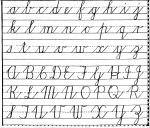Cursive Handwriting Charts for Free!
My children are about 9 to 10-years old when they start cursive handwriting. They should have mastered print handwriting. They should learn all the letter forms on the chart before writing in cursive in notebook pages. The writing style we chose is the official South African school cursive form.
They use whiteboard markers to learn the letter shape and practice letter formation on the chart. Once the child masters lower case letters , they learn the upper case letters. Then they are able to write dictations and copywork in pencil on notebook pages.
You can download the 3 page cursive handwriting charts here – Cursive Handwriting Chart
Some more tips:
- Daily practice helps mastery
- ‘Talk’ through the letter formation – e.g.: flow up, loop over, straight down, touch the base line, slide up the line, curve up to mid line …
- Use a H pencil instead of HB as it doesn’t smudge easily
- Use sharp pencils
- Use rubber pencil grip to hold the pencil comfortably and correctly
- Use propelling pencils with the triangle rubber grip
- Sit comfortably, at the correct height table with feet resting on the floor (or foot stool/box/ledge)
- Neatest work for copywork – other writing is functionally neat and legible
- When they accomplish writing in pencil they can begin to use pen
Look at my Handwriting pages for more charts and tips 🙂



Good way of describing, and good piece of writing to obtain facts on the topic of my presentation subject matter,
which i am going to present in university.
LikeLike
I love the fact that you have these charts readily available and free as some schools here are no longer offering cursive handwriting. The only change/difference I see is the cursive structure for the letter “Q”. I was taught to write it resembling the number “2” when capitalized. Thanks!
LikeLike
its so convienet when i have to do my homework.its so smart of you to do this for us.thank you very much .i hope you have a good day sincerly,sarah michelle walsh.
LikeLike
Pingback: NinaLazina » Cursive Writing Without Tears
Nadene
After two days of searching the internet to find the font you are using for the worksheets (which are absolutely marvelous), I am now desperate. Are you able to identify the actual font you use please? Jarman has a font that is close but the Z is not as we in South Africa do it. Can you please help?
Many thanks.
Megan
LikeLike
@Megan, the official South African cursive font used in our government schools is called ABC Cursive Plain. I have not found a commercial version. The big problem that I have with this font is that the letters do NOT link to each other and the ‘s’ does not close. Instead, I use “Skryptaag Tryout” I found on a free font site. Hope this helps 🙂
LikeLike
I love your ideas. We also use ABC Cursive Plain –
You can get the letters to join if you Choose advance and then turn the “Kerning option” on!
Hope that helps.
LikeLike
Wonderful help, @Michelle DeBeer! Thank you so much! I’ll share your tip with my readers!
LikeLike
1 December 2011, Hello there, my name is Amanda and i am from South Africa. I came accross your website and what a wonderful adventure awaited me!!!!!!!! Gossh so much talent, some much work put into important things to help others! I don’t wish to subscribe as i am not working with any children of any kind. Mayb u can direct me how to subscribe to other activities on your web?
LikeLike
@Amanda, welcome and thank you! I don’t know any way to subscribe to only some activities here, but you could subscribe, see if posts are relevant and simply delete those that are not. (You can easily opt out and unsubscribe at any time) 🙂
LikeLike
I like your South African cursive writing style but it’s interested to learn that your children don’t start learning cursive until 9 or 10. In the UK most schools start teaching cursive at about 6 or 7 years, but some are teaching a cursive style right from the start of school (age 4), which is quite tricky for the children as you can imagine.
LikeLike
Many parents and schools choose a print style that is quite close to a joined print which is their cursive style (e.g.: italics). This is to ease the transition and avoid re-teaching new letter forms when learning cursive. If this is the case, as in your font style used, then cursive could be learnt when the child is still young, but ready to join his letters in cursive.
LikeLike